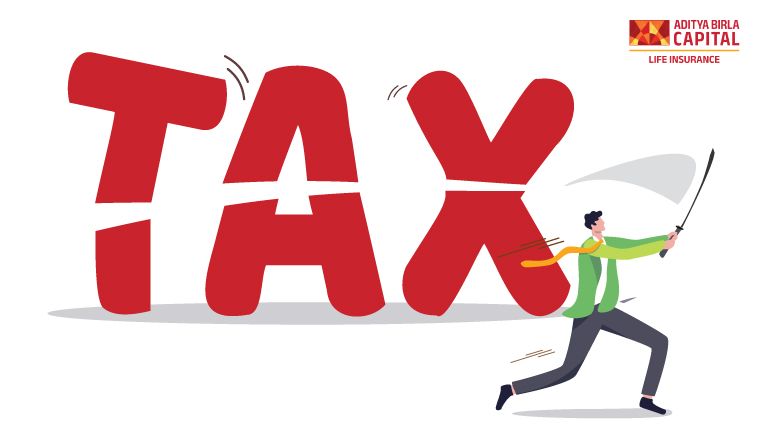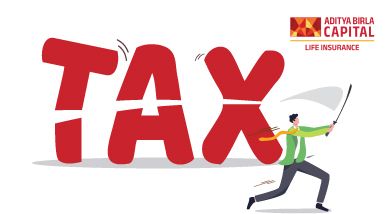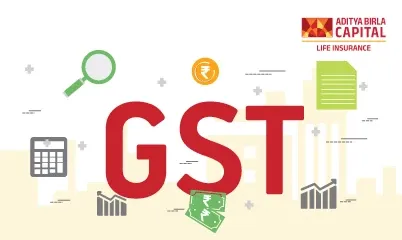Aditya Birla Sun Life Insurance Company Limited
How to reduce your Taxable Income?

Plan Smarter, Live Better!

Thank you for your details. We will reach out to you shortly.

Currently we are facing some issue. Please try after sometime.


- Table of Contents
There's a common meme floating around – that of a crying child and a half-eaten ice cream next to it. The caption goes that the parent takes a big chunk of the ice cream as tax, upsetting the child.
Think about it. Imagine you buy this big cone of ice cream and have to compulsorily part a portion of it. That's what happens with our income, right? Up to 30% of the salaried income is paid as tax. (30% tax is for higher tax slab income) A similar amount for other kinds of income.
But what if you could reduce the amount of tax you pay? The government itself offers many options to do so. Let's have a look.
Reduce up to Rs 45,000 tax:
Reduce up to Rs 45,000 tax: If you invest in certain options, you can reduce your taxable income by up to Rs 1.5 lakh. This helps you reduce your tax payment by up to Rs 45,000 (30% of Rs 1.5 lakh). Here's an example:
Rajesh has a taxable income of Rs 9.5 lakh. This means, he owes 20% or Rs 1.025 lakh as tax. But he invests Rs 1.5 lakh in various investment options that offer him a tax deduction. This reduces his taxable income to Rs 8 lakh and his net tax payment to Rs 72,500. That's a saving of Rs 30,000!
Here are the investment options that can help you avail a tax deduction of up to Rs 1.5 lakh under Section 80C of the Income Tax Act.
- Life insurance of all kinds:
Term insurance, ULIPs, Endowment plans, Monthly income plans, etc. - Tax-saving Mutual Funds:
The official term for such Mutual Funds is ELSS or Equity-Linked Savings Schemes. These MFs, however, have a 3-year lock-in period. During this period, you cannot withdraw your investments. - 5-year bank deposits:
Any fixed deposit with a maturity period of 5 years can help you get a tax deduction under Section 80C. - Government schemes:
Many schemes like SCSS or Senior Citizen Savings Scheme are also eligible to get you a tax deduction. They typically have a maturity period of 5 years too. - Provident Fund:
Public Provident Fund (PPF) is one of the most favoured options for tax saving. However, it has a lock-in period of 15 years. Employees also enjoy a tax deduction on their Employee Provident Fund (EPF) contributions.
Extra Tax Reduction of Rs 15,000:
In addition to the above investment options, you can invest in the National Pension Scheme or NPS too. This can help you get another tax deduction of up to Rs 50,000.
Let's take Rajesh's earlier example. If he had invested Rs 1.5 lakh in a ULIP and another Rs 50,000 in NPS, his net taxable income would fall to Rs 7.5 lakh. This means, he would owe only Rs 62,500 as tax.
Reduce up to Rs 30,000 in tax with Health Insurance:
Reduce up to Rs 30,000 in tax with Health Insurance: Let's move to another section of the Income Tax Act - Section 80D. As per this rule, the premium you pay on your health insurance can be deducted from your taxable income. In fact, you can claim a tax deduction on the premium you pay for yourself, your spouse, children as well as your parents.
Let's have a look at how much deduction you can get from buying health insurance for your family:
Individuals under 60 years of age: up to Rs 25,000
Individuals over 60 years of age: up to Rs 50,000
Let's take 45-year-old Rajesh's example. Here are the health insurance policies he purchased:
|
For |
Premium |
|
Self |
Rs 15,000 |
|
Spouse and children |
Rs 20,000 |
|
Parents (aged 65 and 70) |
Rs 65,000 |
In addition, he can enjoy another deduction of Rs 50,000—the upper limit for senior citizen parents
So, the total deduction is Rs 75,000. This can help him save another Rs 15,000 in tax. His net tax liability is now Rs 47,500.
Donate to save tax
The money you give to a non-profit organisation, a scientific research association, social development programmes, or even a political organisation can help you reduce your taxable income further.
However, this is where it gets a little complex—there are various categories of donations, each of which can get you a different amount of tax deduction.
For example, in some cases, only 50% of the donations can be deducted from the taxable income; in other cases, 100% of the donation amount can be used to deduct tax. There are also various limits applicable.
So, it's important to check with the organisation you are donating money too. They have to give you a donation receipt, which will mention the tax deduction details.
Buy a house with a loan and save tax
You can reduce your tax by up to Rs 1.2 lakh if you buy a house using a home loan. Under Section 24, you can avail a tax deduction of up to Rs 2 lakh on the home loan interest you repaid. In addition to this, you can enjoy another deduction of up to Rs 1.5 lakh on the home loan principal amount.
And if you take a loan that's less than Rs 35 lakh in value, then you can enjoy another Rs 50,000 deduction under Section 80EE.
This means a total deduction of up to Rs 4 lakh. Meaning, you save up to Rs 1.2 lakh
Let's take Rajesh's example and understand this. Rajesh borrowed Rs 50 lakh to purchase a house. For this, he pays a monthly EMI of Rs 38,174 per month.
|
|
Amount repaid |
Tax deduction |
|
Interest |
3,71,329
|
2,00,000
|
|
Principal |
86,758
|
86,758
|
|
Section 80EE |
Loan amount over Rs 35 lakh |
Not applicable |
|
Total deduction |
Loan amount over Rs 35 lakh
|
2,86,758
|
This means, Rajesh's total taxable income is reduced by Rs 2.86 lakh to Rs 3.79 lakh. This means he now has to pay only 5% tax as his taxable income is under Rs 5 lakh. This amounts to Rs 6,950.
His total tax liability has now fallen to a mere Rs 6,950 from Rs 1.025 lakh earlier. Let's have a look at the whole calculation:
|
|
Taxable income |
|
Tax liable |
|
Income |
9,50,000 |
(5% of Rs 2.5 lakh + 20% of Rs 4.5 lakh) |
1,02,500 |
|
Section 80C deduction of Rs 1.5 lakh |
8,00,000 |
(5% of Rs 2.5 lakh + 20% of Rs 3 lakh) |
72,500 |
|
Rs 50,000 NPS deduction |
7,50,000 |
(5% of Rs 2.5 lakh + 20% of Rs 2.5 lakh) |
62,500 |
|
Health insurance deduction of Rs 75,000 |
6,75,000 |
(5% of Rs 2.5 lakh + 20% of Rs 1.75 lakh) |
47,500 |
|
Home loan deduction of Rs 2.86 lakh (rounded) |
3,89,000 |
(5% of Rs 1.39 lakh) |
6,950 |
In the first year, he has repaid an interest amount of Rs 3,71,329 and a principal amount of Rs 86,758.
This means, he can avail a total deduction of:
Last words
Done smartly, investing can help you save a lot of tax money. However, it's also important to keep in mind your life goals and other factors like risk, return expectations, investment period, payouts, etc. before you decide which investment option to invest in.
Plus, the investment amount you withdraw or redeem may also attract tax in varying proportions. For example, insurance payouts are not taxable at all. Mutual fund redemptions or stock sales, meanwhile, may attract tax depending on the type of fund and investment period.
This may probably be why investors often consider an investment-linked insurance plan like a ULIP or a Monthly Income plan or a Guaranteed plan. They offer tax benefits1 as well as help build wealth over the long term.
Considering a tax-friendly insurance plan that can also help you generate wealth? Check out ABSLI Wealth Assure Plus Plan here Plan here.
Thank you for your details. We will reach out to you shortly.
Thanks for reaching out. Currently we are facing some issue.
Buy ₹1 Crore Term Insurance at Just ₹575/month1
ABSLI DigiShield Plan
Life cover up to 100 years of age.
Joint Cover Option
Inbuilt Terminal Illness Benefit
Tax Benefit^
Return of Premium Option~
Life Cover
₹1 crore
Premium:
₹575/month1
Most Popular Calculator
Guaranteed returns after a month¹
ADV/3/20-21/2512







